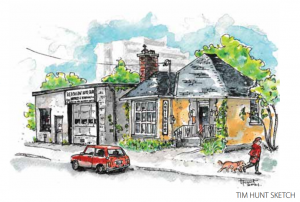Quinn Abugov
A “hidden gem” in Old Ottawa East has recently closed its doors after 37 years serving the local community.
Opened in 1983 by Boston native Arthur Bousquet, Donohue and Bousquet Antiques was considered by some, to not only possess the best antique silverware in Ottawa, but in all of Canada.
Bousquet, a Vietnam War veteran, met his wife Lelia on a visit to Canada, and soon after moved to Ottawa fulltime after short stints operating similar businesses in Quebec City and Valcartier, Quebec.
After opening up his first Ottawa store on Somerset Street West a number of years prior, he moved the shop to its location on Hawthorne Avenue in 1983. Sandwiched between Redshaw Auto Care to its east and Ballantyne Park to the west, the unassuming bungalow turned storefront quickly became a local destination for antiquing hobbyists, and Ottawa’s diplomatic and political elite alike.
It’s the type of place where local residents and hobbyists could rub elbows with sitting Prime Ministers, Supreme Court Chief Justices, actors and members of the diplomatic community.
Bousquet was unavailable to speak with The Mainstreeter, however, we spoke to long-time store manager, Collin O’Leary, who has been an employee of Donohue and Bousquet since 1984.
“This past May marked 37 years,” said O’Leary, who joined up with Bousquet, in part, because they both shared an interest in unique and rare silverware. “I’d been in the antique business for a while, having worked in several stores and owning my own shop on Bank and Argyle. I went to Arthur Bousquet’s store because we both specialized in silver, and I thought it would be a good fit,” says O’Leary.
In the business’s heyday, during the antique boom of the 1990’s, the diverse collection on display included vintage Canadian, American and European silverware, in addition to other rare antique items from around the globe.
While O’Leary’s love of the antique business has not waned, the industry today, he says, looks much different than it did nearly 40 years ago.
First off, take the shopping experience itself.
“Antique stores are very directional, meaning that people used to make a point of going to them. Nowadays, you don’t see a consistent interest in antiques, it’s mostly people walking in off the street, browsing,” says O’Leary.
Secondly, the collecting habits have changed.
“People are buying items because of how they look, not because of the history behind them. In the last 40 years, people would be coming in looking for specialty silver, early dated artifacts, specific makers of products, mahogany.”
And lastly, a shift in demographics.
“Collectors are getting older, and the younger generation is into vintage items and things like chalk painting wood furniture, so the market has changed for your average antique shop around town.” O’Leary says.
When asked the reason for the shop’s recent closure, O’Leary was candid in his response. “You always hate to close,” he says. “Arthur had been running the business in some form for 50 years, but the market has changed drastically since 9/11. There’s been a shift away from traditional antique shops to digital commerce and Arthur and I both prefer the old way of doing things, so it was simply time to close.




